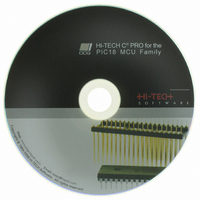SW500007 Microchip Technology, SW500007 Datasheet - Page 136

SW500007
Manufacturer Part Number
SW500007
Description
PICC-18 PRO
Manufacturer
Microchip Technology
Type
Compilerr
Series
PIC18r
Specifications of SW500007
Supported Families
PIC18
Core Architecture
PIC
Software Edition
Professional
Kit Contents
Software And Docs
Mcu Supported Families
PIC18
Tool Function
Compiler
Tool Type
Compiler
Lead Free Status / RoHS Status
Not applicable / RoHS Compliant
For Use With/related Products
PIC18 Series
Lead Free Status / Rohs Status
Lead free / RoHS Compliant
Other names
015P
778-1002
778-1002
778-1002
778-1002
- Current page: 136 of 486
- Download datasheet (4Mb)
Invoking the Linker
5.8 Invoking the Linker
The linker is called HLINK, and normally resides in the BIN subdirectory of the compiler installation
directory. It may be invoked with no arguments, in which case it will prompt for input from standard
input. If the standard input is a file, no prompts will be printed. This manner of invocation is
generally useful if the number of arguments to HLINK is large. Even if the list of files is too long
to fit on one line, continuation lines may be included by leaving a backslash \ at the end of the
preceding line. In this fashion, HLINK commands of almost unlimited length may be issued. For
example a link command file called x.lnk and containing the following text:
may be passed to the linker by one of the following:
5.9 Compiled Stack Operation
A compiler can either take advantage of the hardware stack contained on a device, or produce code
which uses a compiled stack for parameter passing between functions and auto variables. Temporary
variables used by a function may also be allocated space in the auto area. (Temporary variables with
names like btemp, wtemp or ltemp are not examples of such variables. These variables are treated
more like registers, although they may be allocated memory.) A compiled stack consists of fixed
memory areas that are usable by each function’s auto and parameter variables. When a compiled
stack is used, functions are not re-entrant since local variables in each function will use the same
fixed area of memory every time the function is invoked.
the structure of function calls. The call graph consists of one or more call trees which are defined
by the program. Each tree has a root function, which is typically not called by the program, but
which is executed via other means. The function main is an example of a root function. Interrupt
functions are another. The term main-line code means any code that is executed, or may be executed,
by a function that appears under the main root in the call graph. See Section
information on the call graph which is displayed in the map file.
auto and temporary variables. Temporary variables act just like auto variables. Local variables
which are qualified static are not part of this block. For situations where a compiled stack is used,
122
Fundamental to the compiled stack is the call graph which defines a tree-like hierarchy indicating
Each function in the call graph is allocated an auto/parameter block (APB) for its parameter,
-Z -OX.OBJ -MX.MAP \
-Ptext=0,data=0/,bss,nvram=bss/. \
X.OBJ Y.OBJ Z.OBJ C:\HT-Z80\LIB\Z80-SC.LIB
hlink @x.lnk
hlink < x.lnk
5.10.2.2
Linker and Utilities
for detailed
Related parts for SW500007
Image
Part Number
Description
Manufacturer
Datasheet
Request
R

Part Number:
Description:
Manufacturer:
Microchip Technology Inc.
Datasheet:

Part Number:
Description:
Manufacturer:
Microchip Technology Inc.
Datasheet:

Part Number:
Description:
Manufacturer:
Microchip Technology Inc.
Datasheet:

Part Number:
Description:
Manufacturer:
Microchip Technology Inc.
Datasheet:

Part Number:
Description:
Manufacturer:
Microchip Technology Inc.
Datasheet:

Part Number:
Description:
Manufacturer:
Microchip Technology Inc.
Datasheet:

Part Number:
Description:
Manufacturer:
Microchip Technology Inc.
Datasheet:

Part Number:
Description:
Manufacturer:
Microchip Technology Inc.
Datasheet:










